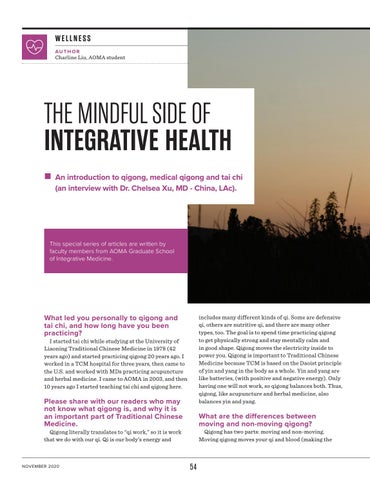WELLNESS AUTHOR
Charline Liu, AOMA student
THE MINDFUL SIDE OF INTEGRATIVE HEALTH n An introduction to qigong, medical qigong and tai chi (an interview with Dr. Chelsea Xu, MD - China, LAc).
This special series of articles are written by faculty members from AOMA Graduate School of Integrative Medicine.
What led you personally to qigong and tai chi, and how long have you been practicing?
includes many different kinds of qi. Some are defensive qi, others are nutritive qi, and there are many other types, too. The goal is to spend time practicing qigong to get physically strong and stay mentally calm and in good shape. Qigong moves the electricity inside to power you. Qigong is important to Traditional Chinese Medicine because TCM is based on the Daoist principle of yin and yang in the body as a whole. Yin and yang are like batteries, (with positive and negative energy). Only having one will not work, so qigong balances both. Thus, qigong, like acupuncture and herbal medicine, also balances yin and yang.
I started tai chi while studying at the University of Liaoning Traditional Chinese Medicine in 1978 (42 years ago) and started practicing qigong 20 years ago. I worked in a TCM hospital for three years, then came to the U.S. and worked with MDs practicing acupuncture and herbal medicine. I came to AOMA in 2003, and then 10 years ago I started teaching tai chi and qigong here.
Please share with our readers who may not know what qigong is, and why it is an important part of Traditional Chinese Medicine.
What are the differences between moving and non-moving qigong?
Qigong has two parts: moving and non-moving. Moving qigong moves your qi and blood (making the
Qigong literally translates to “qi work,” so it is work that we do with our qi. Qi is our body’s energy and
NOVEMBER 2020
54






















